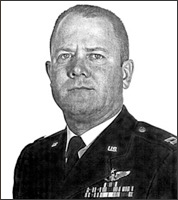

Edwin Lee Atterberry was a Captain in the United States Air Force when he was taken Prisoner of War in North Vietnam on 12 August 1967. Atterberry was born on 03 March 1934, and his home city of record is Dallas, Texas. Atterberry died in captivity; his remains were returned in 1974.
The Incident
On August 12, 1967, Capt. Edwin L. Atterberry and Capt. Thomas V. Parrott were sent on a reconnaissance mission over Ha Bac Province, North Vietnam. When they were about 10 miles northeast of the city of Gia Lam, the aircraft was hit by enemy fire and the crew was forced to eject. Both Atterberry and Parrott were captured by the North Vietnamese, and moved to the Hanoi prison system, where they joined other Americans captured before them.
Impriosonment
On May 10, 1969, after a year of planning, Atterberry and a fellow POW, John A. Dramesi, made an almost miraculous escape from prison. The two slipped through the roof and traveled three miles over 12 hours, but were recaptured.
Dramesi recalls the torture he could not speak of for many months. For the escape attempt, Dramesi was put face down on a table, and while one guard held his head, two others beat him with a four foot length of rubber taken from an old automobile tire. They also slapped him repeatedly in the face. This went on for days, in ninety-minute sessions, after which the left side of Dramesi's head was swelled up like a pumpkin. They also put Dramesi on a bread and water diet for 30 days. At other times during the next two weeks, Dramesi's arms were bound tightly together behind him and his wrists and ankles cuffed in heavy irons. A rope was looped around a two-inch-thick bar attached to his ankle irons, taken around his shoulders and his head drawn between his knees.
He was held in this position for 24 hours without sleep. His circulation impaired, the flesh on his ankles died, and he still bears the scars. After two weeks, the Vietnamese realized he might lose his feet, so they removed the irons and treated the wounds, but replaced them. Dramesi wore the irons continuously for 6 months, removing them only once a week when allowed to wash.
After 38 days of this torture, Dramesi was near death.
When Dramesi and Atterberry were recaptured, one of the other POWs recalls shaking Atterberry's hand. This was the last time he was seen by any Americans. Like Dramesi, Atterberry was tortured, but Atterberry did not survive. The Vietnamese told other POWs that Atterberry died of an "unusual disease." The POWs knew the disease was attempting to escape.
Not only Dramesi and Atterberry were punished. The entire POW populace was systematically worked over. After the episode was over, the senior officers outlawed further escape attempts unless they could meet a set of stringent conditions, including outside help. Planning escapes did not cease, but the actual attempts were put on hold. This is an excellent example of how the Code of Conduct was "bent" to the circumstances at hand. A necessary modification was made to ensure the survival of the prisoners; it having been determined that it was impossible to follow the Code literally under the circumstances.
The result of the Vietnam experience was a "new" code, the same in letter, but different in spirit and intent than the pre-Vietnam version. Most agree it is a more realistic form of guidance, and it stresses community organization and a chain of command. It releases the POW from the "die-before-you-talk" syndrome that brought so many to personal shame in Vietnam when they were finally broken. (And all of those put to the test who survived were broken.)
Returned POWs have a special place in their hearts for Atterberry and each of them knows what happened to Atterberry could have happened to any of them, and in many cases, nearly did.
Years Later...
Thomas V. Parrott was released from Hanoi on March 14, 1973; he served five and one-half years as a POW. Atterberry's remains were returned in March 1974. Both Parrott and Atterberry were promoted to the rank of Major during their captivity.
Sources
Biographical and incident of loss information was obtained from either POW/NET and/or Task Force Omega, Inc (unless otherwise noted). Additional information may be found via remembrances at The Vietnam Veterans Memorial Fund or The Virtual Wall Vietnam Veterans Memorial.